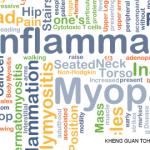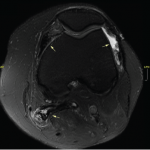A novel area of weakness research focuses not on muscle, but on the brain. A recent study tested the hypothesis that the cerebral cortex is a critical determinant of muscle strength and weakness and that a high level of corticospinal inhibition is an important neurophysiological factor regulating force generation.9
A group of healthy individuals underwent four weeks of wrist–hand immobilization to induce weakness. Another group also underwent four weeks of immobilization, but they were trained in mindfulness, performing mental imagery exercises of strong muscle contractions five days per week. Mental imagery has been shown to activate several cortical areas that are involved with actual motor behaviors, and in this study, this activity attenuated the loss of strength by half.
Mind over muscle? I wish it were true.
 Simon M. Helfgott, MD, is associate professor of medicine in the Division of Rheumatology, Immunology and Allergy at Harvard Medical School in Boston.
Simon M. Helfgott, MD, is associate professor of medicine in the Division of Rheumatology, Immunology and Allergy at Harvard Medical School in Boston.
References
- Helfgott SM, Karlson E, Beckman E. Misinterpretation of serum transaminase elevations in ‘occult’ myositis. Am J Med. 1993 Oct;95(4):447–449.
- Lightfoot AP, Nagaraju K, McArdle A, et al. Understanding the origin of non-immune cell-mediated weakness in the idiopathic inflammatory myopathies – potential role of ER stress pathways. Curr Opin Rheumatol. 2015 Nov;27(6):580–585.
- Cushing H. The basophil adenomas of the pituitary body and their clinical manifestation (pituitary basophilism). Bulletin of the Johns Hopkins Hospital. 1932;50:137–195.
- Vijayakumar A, Ashwath G, Thimmappa D. Thyrotoxic periodic paralysis: Clinical challenges. Jo J Thyroid Res. 2014;2014:649502.
- Waning DL, Guise TA. Molecular mechanisms of bone metastasis and associated muscle weakness. Clin Cancer Res. 2014 Jun 15;20(12):3071–3077.
- Roos EM, Herzog W, Block JA, et al. Muscle weakness, afferent sensory dysfunction and exercise in knee osteoarthritis. Nat Rev Rheumatol. 2011 Jan;7(1):57–63.
- Longman J. 85-year-old marathoner is so fast that even scientists marvel. The New York Times. 2016 Dec 28.
- Associated Press. 105-year-old Frenchman rides 14 miles in a hour to set world record. ESPN. 2017 Jan 4.
- Clark BC, Mahato NK, Nakazawa M, et al. The power of the mind: The cortex as a critical determinant of muscle strength/weakness. J Neurophysiol. 2014 Dec 15;112(12):3219–3226.


